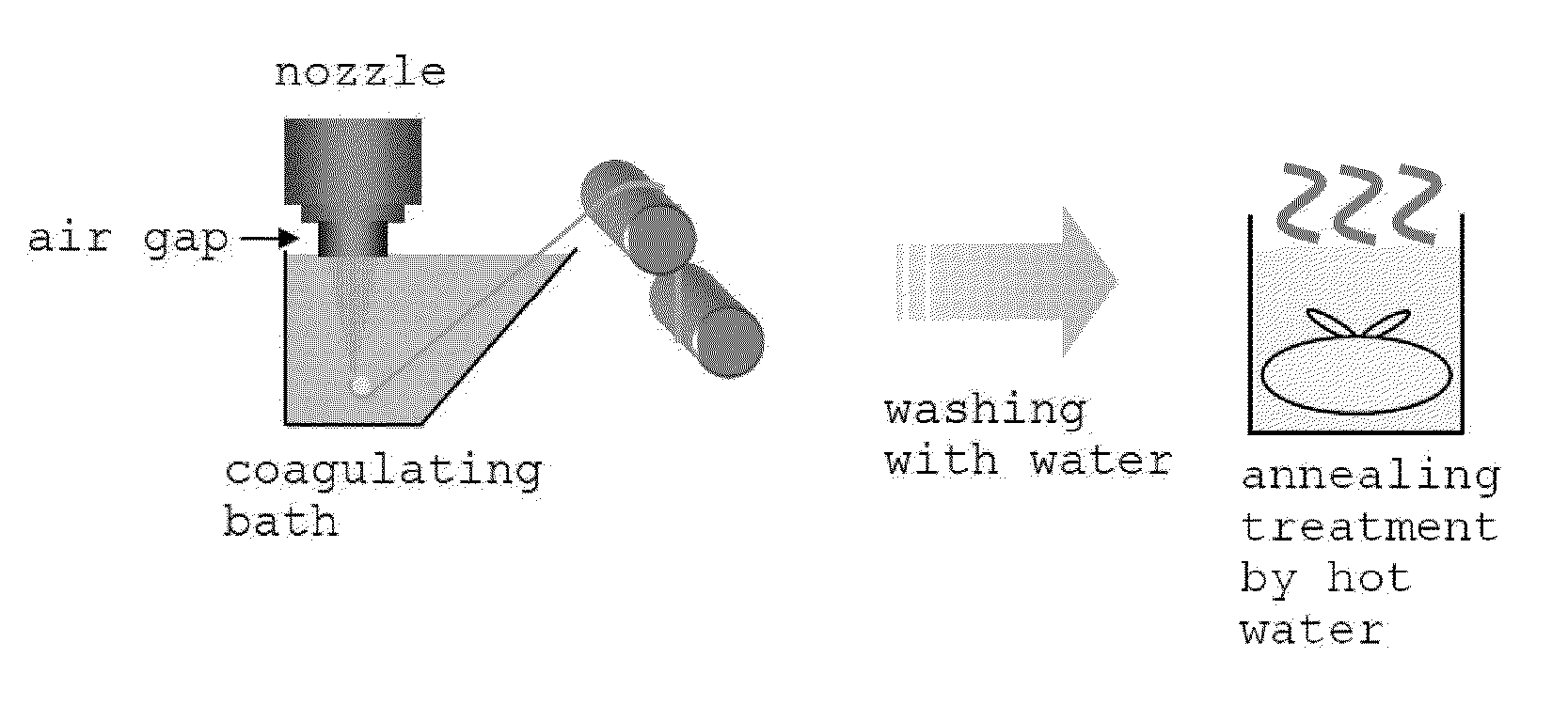Hollow fiber type reverse osmosis membrane and method for manufacturing the same
a reverse osmosis membrane and fiber type technology, applied in the direction of membranes, filtration separation, separation processes, etc., can solve the problems of complex manufacturing steps, low water permeability, and low water permeability when used under low pressure, and achieve high salt rejection rate, high filtration rate, and low running cost
- Summary
- Abstract
- Description
- Claims
- Application Information
AI Technical Summary
Benefits of technology
Problems solved by technology
Method used
Image
Examples
example 1
[0064]Cellulose triacetate (CTA, Daicel, LT35) (41% by weight), 49.9% by weight of N-methyl-2-pyrrolidone (NMP, Mitsubishi Chemical), 8.8% by weight of ethylene glycol (EG, Mitsubishi Chemical) and 0.3% by weight of benzoic acid (Nacalai Tesque) were uniformly dissolved at 180° C. to give a dope. The resulting dope was defoamed in vacuo, extruded from an arc-type nozzle (divided into three) at 163° C. into the space which is isolated from the outer air and, after space time of 0.03 second, dipped into a coagulating bath of 12° C. comprising NMP / EG / water in 4.25 / 0.75 / 95. After that, the hollow fiber membrane was washed by a multistage inclination gutter method and shaken off when the membrane was still in a wet state. The resulting hollow fiber membrane was dipped in water of 60° C. and subjected to an annealing treatment for 40 minutes.
[0065]The resulting hollow fiber membrane had inner diameter of 100 μm, outer diameter of 175 μm and hollow rate of 33%.
[0066]Modules of 1,000 mm len...
example 2
[0067]Cellulose triacetate (CTA, Daicel, LT35) (41% by weight), 49.9% by weight of N-methyl-2-pyrrolidone (NMP, Mitsubishi Chemical), 8.8% by weight of ethylene glycol (EG, Mitsubishi Chemical) and 0.3% by weight of benzoic acid (Nacalai Tesque) were uniformly dissolved at 180° C. to give a dope. The resulting dope was defoamed in vacuo, extruded from an arc-type nozzle (divided into three) at 163° C. into the space which is isolated from the outer air and, after space time of 0.03 second, dipped into a coagulating bath of 12° C. comprising NMP / EG / water in 4.25 / 0.75 / 95. After that, the hollow fiber membrane was washed by a multistage inclination gutter method and shaken off when the membrane was still in a wet state. The resulting hollow fiber membrane was dipped in water of 52° C. and subjected to an annealing treatment for 40 minutes.
[0068]The resulting hollow fiber membrane had inner diameter of 100 μm, outer diameter of 175 μm and hollow rate of 33%.
[0069]Modules of 1,000 mm len...
example 3
[0070]Cellulose triacetate (CTA, Daicel, LT35) (41% by weight), 49.9% by weight of N-methyl-2-pyrrolidone (NMP, Mitsubishi Chemical), 8.8% by weight of ethylene glycol (EG, Mitsubishi Chemical) and 0.3% by weight of benzoic acid (Nacalai Tesque) were uniformly dissolved at 180° C. to give a dope. The resulting dope was defoamed in vacuo, extruded from an arc-type nozzle (divided into three) at 163° C. into the space which is isolated from the outer air and, after space time of 0.03 second, dipped into a coagulating bath of 12° C. comprising NMP / EG / water in 4.25 / 0.75 / 95. After that, the hollow fiber membrane was washed by a multistage inclination gutter method and shaken off when the membrane was still in a wet state. The resulting hollow fiber membrane was dipped in water of 68° C. and subjected to an annealing treatment for 40 minutes.
[0071]The resulting hollow fiber membrane had inner diameter of 100 μm, outer diameter of 175 μm and hollow rate of 33%.
[0072]Modules of 1,000 mm len...
PUM
| Property | Measurement | Unit |
|---|---|---|
| Temperature | aaaaa | aaaaa |
| Temperature | aaaaa | aaaaa |
| Length | aaaaa | aaaaa |
Abstract
Description
Claims
Application Information
 Login to View More
Login to View More - R&D
- Intellectual Property
- Life Sciences
- Materials
- Tech Scout
- Unparalleled Data Quality
- Higher Quality Content
- 60% Fewer Hallucinations
Browse by: Latest US Patents, China's latest patents, Technical Efficacy Thesaurus, Application Domain, Technology Topic, Popular Technical Reports.
© 2025 PatSnap. All rights reserved.Legal|Privacy policy|Modern Slavery Act Transparency Statement|Sitemap|About US| Contact US: help@patsnap.com



